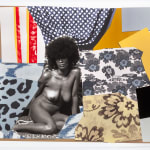Mickalene Thomas USA, b. 1971
109.2 x 163.8 cm
Further images
-
(View a larger image of thumbnail 1
)

-
(View a larger image of thumbnail 2
)

-
(View a larger image of thumbnail 3
)

-
(View a larger image of thumbnail 4
)

-
(View a larger image of thumbnail 5
)

-
(View a larger image of thumbnail 6
)

-
(View a larger image of thumbnail 7
)

-
(View a larger image of thumbnail 8
)

-
(View a larger image of thumbnail 9
)

-
(View a larger image of thumbnail 10
)

Says Thomas, “Growing up, my mother would walk into a room and her beauty was so powerful that she could get whatever she wanted from people—attention, conversation. People just wanted her energy. I think beauty has a form of power. And then on top of a woman being beautiful that way, if she’s intelligent, then that’s a double. I’m just trying to understand the power of that beauty.”
Conceptually, collage is about representation and contextualization—what is allowed to be seen versus what is covered up, and how a constructed or manipulated images is perceived and understood by a viewer. Mickalene Thomas’s collages embody the effort to build spaces of beauty and contemplation in which Black femininity and sensuality can be represented and contextualized in confident, joyful, celebratory ways, free from the limitations of history and the majoritarian gaze. Thomas’s process of building a final image always begins with source photographs, which are collaged together with other materials within an evolving pictorial space. She then re-collages the collage until concept, materials, subject, and image coalesce. That final image might then be translated further into an oil painting. A crucial material difference between the collage and the painting is that the collage literally contains a history of its own making, hidden among the layers. Thomas has even described her oil paintings as never completely satisfying in themselves. “I always felt like I had to put something on it or it was never finished,” she says. Using chopsticks to add rhinestones onto the painting’s surface is one way she continues adding literal and metaphorical layers to the final image.









